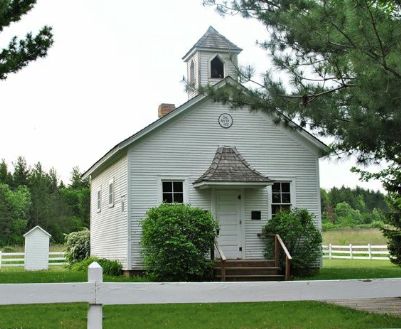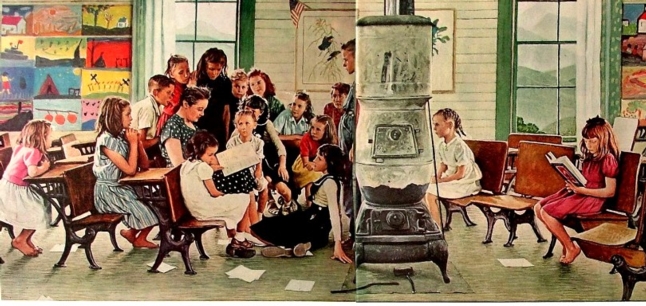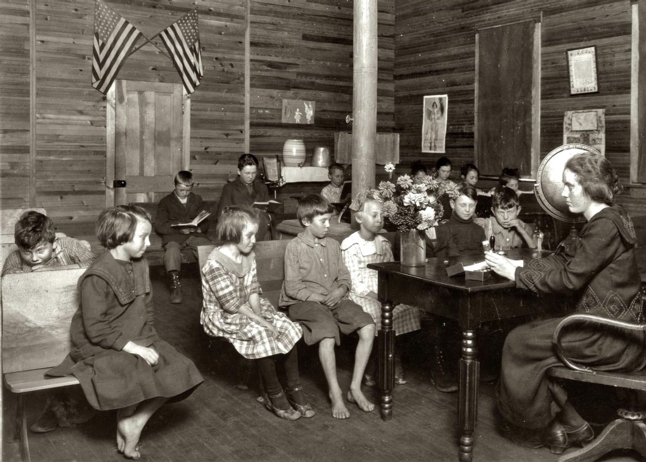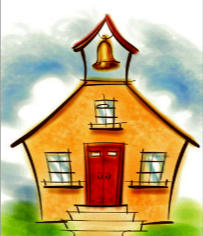
TIGER ALUMNI CENTER -- ERHS/RCHS

Age of One-Room Schools
Country School House Culture
January 14, 2017
![]()
I've got Richland County’s history of one-room, rural school culture on my mind. I’ve spent several evenings reading “Before the Big Yellow Bus.” Also, this past week, I enjoyed a conversation with Roland, our “Bug Man,” who shared some of his memories of his being a student at one.
I have been reading “Before the Big Yellow Bus” (Yellow Bus) by Ron Scherer (ERHS Class of 1962) and his cousin Yvonne Scherer Meckfessel (Class of 1964). I enjoyed the many pictures of the students and teachers of the one-room schools in the county, in part, looking for a picture of my Aunt Rowena (I’ll explain soon). I wish their book had been required reading for all who attended ERHS (Now RCHS). I say so as I was surprised to learn so much about what was, at the time I was a youth, recent history of the education system of the townships in our Richland County.
When I was a Junior High student in 1954, I was attending school in a building that was the pride and joy of the locals since 1915. I didn’t realize that just two years before my arrival, the building had served its last year as a high school – for the Olney Township High School class of 1952.
At the time I did not know that my Aunt Rowena had taught in one of the county’s one-room rural schools in the late 1920s, having graduated from OTHS in 1927. I didn’t know that my Grandfather Williams had served on the township school board in the 1940’s leading up to the consolidation of schools into the district that I knew was the East Richland school district.
In short, I had no idea about the history that was common life to my mother’s generation.

As an adult, from my Barrett cousins, I learned that my Aunt Rowena Williams Barrett (OTHS, Class of 1927) taught for one year in one of the county's many one-room, rural grade schools. Boy, do I wish I knew more. I’d like to know everything about her experience teaching that year. She was there one year; her next experience was teaching grade school in Olney. That must have been at Central (which by the way was cross Camp Street from her parents' and my Grandparents’ home).
Reading “Yellow Bus” got my mind going. On page after page a historical detail or the list of students under a picture of those who were attending the one-room school connected me to related events in my family. I found myself looking at unknown teachers wondering if she were Aunt Rowena.
Of my Barrett cousins, only Judy remains. She was born years after her mother left Olney and teaching. She remembers almost nothing of her mom talking about those years. She can say that “Mom was a loving woman but strict. I certainly believe she would have had good behavior at her school.” She would smile: “They would have been in love with her.”
I agree. I loved her.
--- --- ---
For years now I have enjoyed talking to a lifetime local resident named Roland who attended a one-room school. One such talk occurred this past week when he visited. As a result of our conversation, he got me wondering and wishing I knew more. And so I have been paging “Yellow Bus.”

Our home, being so far south, in “Dixie,” must be treated for bugs “year-round.” Roland does that for us. Somehow we got talking about education, again. Perhaps my being in slippers without socks triggered the connection with his schooling when kids down here in the forties and fifties went to school barefoot. My face must have registered some surprise as he continued smiling.
He reported that going barefoot was part of the culture as most families could not afford to supply children with their own shoes as their shoe sizes changed too often. Many had shoes for special use, like going to church. And most of those were hand-me-downs. “We all went barefoot all the time. Our soles were hard and walking didn’t hurt, was not a hardship. Going to school was just part of our daily routine.”
He said that most of his schoolmates walked to school from their family farms barefoot all school year, except on the rare freezing winter day when each wore something, ‘hand-me-down’ pairs, if any were available. Others, without such, would wear several pairs of socks.
I joked. I reported that my nickname when I was in junior high school was “Boots,” because my size kept changing and I’d get new ones. Their new shine called attention to their being new.
“Drove the family truck barefoot both around the farm and on the local roads,” he said. “Went squirrel and rabbit hunting barefoot – made slipping up on the game easier.”

Roland also has talked about boys always having a rifle with them, even walking to their one-room school and later high school. At school, the walkers left the rifles against a wall. Those who drove a truck, kept their guns on the rear window rack. Often the meat on the family supper table was the result.
I said that I use to ‘dress’ chickens as I would buy whole fryers at the grocery store, but that I had never dressed a squirrel or rabbit. I also volunteered that I knew one Wyoming family that had never purchased meat from a store. Each family member was a skilled hunter and that hunting was their only source of the meat at home.

Roland also told me about the simple, hand-me-down clothes they all wore. He told me that no one judged another kid on his clothes nor any wealth of the family. No one had much. The measure of a fellow student was on his or her behavior.
He reported that he didn't have classmates; he had schoolmates. And, too, their ages varied from that of a child to that of older teenager. Each student's achievements placed him or her at different skill levels for that of several subjects -- the "3 R's" of reading, 'righting,' and 'ritmetic.' So one's friends ranged in age and educational abilities.
--- --- ---
I told Roland about being a new student in high school my freshman year and for the first time I saw kids I did not know.
I was experiencing the mix of students that was the result of the consolidation of schools that had taken place in the late forties that resulted in our new high school built in 1952.
Each class had some new people in it. We didn’t stay strangers very long. I have no memory of any program to help us students understand how we had come to be in the same school; we just began a new stage of our life. If I met someone who lived on a farm, I could image a life based on the weeks each summer when I visited my grandmother who lived on a farm near Mt. Erie. Of course, I was never a working member of a family business. I was a guest who filled my time as well as possible. I didn’t milk a cow; didn’t collect eggs; didn’t hoe the garden; didn’t drive a tractor; didn’t help birth a pig. I had no idea of life on a working family farm. If you noticed at all, you would almost never see these students after school, attending after-class club functions such as participating in sports. They were at home working -- and in many cases on land belonging to someone else, the family doing “share cropping.”
--- --- ---
Being a ‘town boy’ I lived in a world within a few miles of what had been part of the one-room school, rural culture. And knew nothing at all about it. Now, I can read “Before the Big Yellow Bus” by Ron Scherer (ERHS Class of 1962) and his cousin Yvonne Scherer Meckfessel (Class of 1964).






